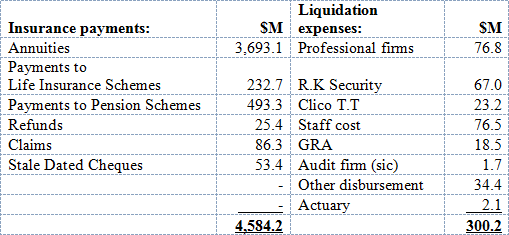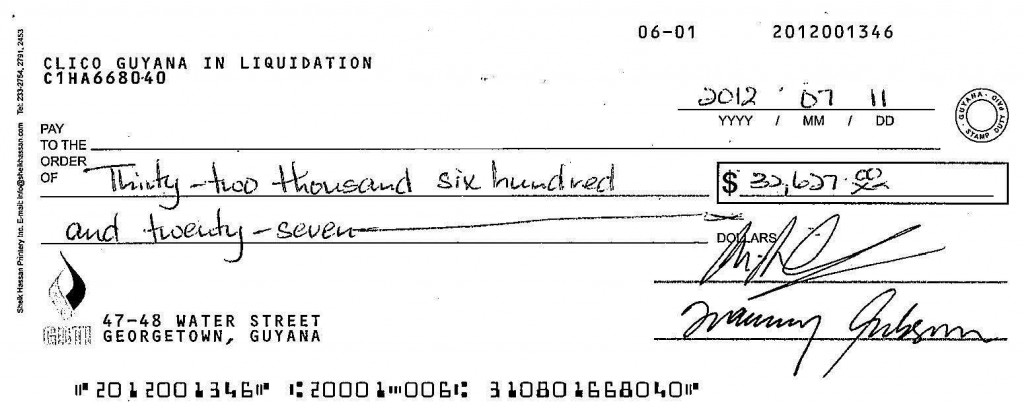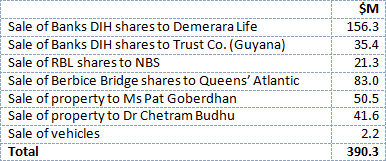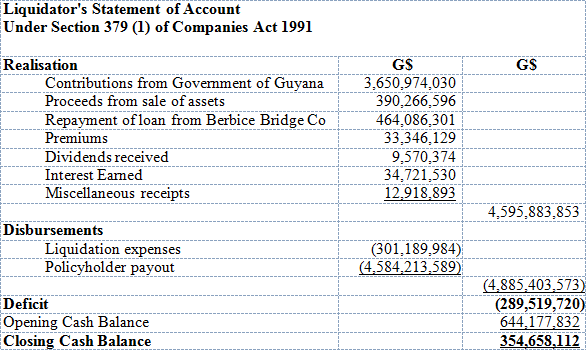Introduction
Perhaps it is the constant stream of news coming out of Trinidad about Commissions of Enquiry, referring files to the Director of Public Prosecution or about police investigations in that country. Or perhaps it is the knowledge that Clico Guyana is partly responsible for the sorry state in which the NIS finds itself, or that the individual who directly contributed to the loss to this country of close to seven billion Guyana dollars walks free, or the unsatisfactory conduct of the liquidation of the company, or the fact that so far my request to the courts for access to relevant files has come up with nought.
Then we have the rounds of telephone interviews being given by politicians to the newspapers and speeches made at hugely expensive dinners in which words like crisis at the NIS or the resolution of the Clico debacle are regarded as taboo. After all, the self-employed could not care two hoots about whether the NIS sinks or swims or whether anyone is held responsible for the failure in which so many authorities are in an incestuous game to protect each other.
To square the circle we have the political opposition which has spent inordinate energy on the “symbol” of Rohee. It is now close to four years since I wrote an open piece in which I said that the parliament must do something about Clico and suggested a number of measures they should consider.
In that call I noted that the National Insurance Scheme (NIS) alone is exposed to Clico for well in excess of six billion dollars or more than 20% of the funds accumulated by the NIS over its forty years of existence. I pointed out that members of Parliament ought to be aware that under the National Insurance Scheme Act any temporary insufficiency in the assets of the (NIS) Fund to meet its liabilities has to be met from appropriations by Parliament. In other words, they would have to approve the money to be funded by taxpayers. The politicians’ response has been less than adequate.
Red ink
Shortly before the call on the National Assembly, I had written about the widening financial instability enveloping Guyana as a result of Clico and Stanford and wrote that when the dust settles, the taxpayers, NIS contributors and beneficiaries, members of pension and medical schemes and depositors in Clico and potentially in Hand-in-Hand Trust (HIHT) and the New Building Society could lose collectively several billions from the fall-out in the financial sector. Of these only the NBS came out largely unscathed since its own $70 million loss had nothing to do with the Clico or Stanford.
Let me briefly fast-forward to today. As of now, while several pension funds and the NIS are still holding anywhere between six and seven billion dollars of worthless paper, the majority of Guyanese including the several politicians have quietly recovered most of their money and some of them began counting their blessings around this time last year. They are not going to open their mouths, while when they do it amounts to nothing, and the private sector is only willing to repeat all kinds of platitudes or safe criticisms sent with signals to the government that this is for show only.
Part of the problem with Clico is that the approach to Clico from the very beginning has been without resort to facts, a point made ad nauseam over the years. Some of it was clearly carelessness or laziness. For example, when the President assured the nation on February 5, 2009 shortly after the collapse began that Clico’s assets were sufficient to meet its liabilities he was repeating a company line without having read the December 31, 2007 analysis showing that 81% of the company’s assets was invested in related parties, all of which were under various degrees of threat (SN February 7; Business Page Feb 8 2009).
Collective failure
But it was partly skin-saving as well since Clico was a collective failure of a number of institutions and individuals. In transactions that came under the supervisory lens of both the Commissioner of Insurance and the Bank of Guyana, no one it appeared noticed or felt competent to deal with a company that issued “insurance policies” with premiums running into billions of dollars having a statutory fund of less than fifty million dollars. As pressure mounted on the President and on those with direct responsibility for the sector, the President in his typical style threatened prosecution against the directors and management of Clico if fraud were found. That threat could not be serious for the simple reason that the President knew that the sole Guyanese director and officer was the company’s CEO who would have been the decider over who should be favoured in getting their money back from the fast sinking ship. That is one secret that never saw daylight.
We knew from the newspapers here that the government of Trinidad and Tobago had moved against CEO Lawrence Duprey and finance specialist Andre Monteil for civil and/or criminal conduct in the collapse of the insurance giant Clico and its parent CL Financial. I reported that a civil lawsuit was brought by Trinidad’s Central Bank and Clico against Duprey and Monteil for alleged mismanagement and misappropriation of Clico assets and that Attorney General Anand Ramlogan had directed that all files coming out of the probe into the collapse of insurance giant Clico should be forwarded to Director of Public Prosecutions (DPP) Roger Gaspard to determine if criminal charges should be laid against Duprey and Monteil.
The story is different in Guyana because of the political and personal relationships that control Guyana. The key players in the Clico saga three years ago were President Jagdeo, Finance Minister Dr Ashni Singh, Clico’s CEO Ms Geeta Singh-Knight all of whom currently hold and enjoy various forms of public office, and Ms Maria Van Beek, former Commissioner of Insurance who left the country following an attempt on her life.
Complicity
They all knew but did nothing about the company breaching the provisions of the Insurance Act and compounded its unlawful conduct by failure to comply with a demand/request by the regulator to repatriate the Statutory Fund. They did nothing of consequence.
It is not as if there are no penalties. Section 19 of the Insurance Act provides that any person who contravenes any provision of the Act, or any of its regulations or any direction or requirement made by the Commissioner of Insurance, is guilty of an offence. Unlike the normal presumption in law where the prosecution has the burden of proving beyond reasonable doubt the guilt of the accused, the Insurance Act shifts the burden to the “person” to prove that s/he did not knowingly commit the offence of omission or commission.
In what in normal circumstances would be real noose-tightening, the law goes on to provide that where an offence is committed by a company – in this case Clico – and the offence is proved to have been committed with the consent or connivance of, or to have been facilitated by any neglect on the part of, any director, principal officer, or other officer or an actuary or auditor of the company, he, as well as the company, shall be deemed to be guilty of the offence. Ms Singh-Knight was both a director and principal officer of the local company and most certainly it would have been to Ms Singh-Knight that the Commissioner of Insurance would have been addressing correspondence and directions.
Playing a supporting role then was the Central Bank Governor who failed to appreciate the nature of the product that Clico was offering and the Bank’s responsibility to regulate it.
One big happy family
Now we have moved on to phase 2 in a liquidation that breaks many of the rules, some players have changed. Ms Van Beek has gone and her place has been taken by a lawyer Ms Tracy Gibson whose supervisory responsibility of the insurance sector is conflicting with her unlawful role as an assistant to the liquidator. Mr Jagdeo is busy with his accolades and ventures while Dr Singh remains as Minister. The Bank of Guyana has seen its Governor appointed liquidator over a company to the demise of which his Bank contributed in no small measure. Ms Singh-Knight has been promoted and for all practical purposes granted a pardon, Chartered Accountant Mr Maurice Solomon is another unlawful assistant liquidator to Mr Williams while Senior Counsel Ashton Chase is the attorney. Mr Solomon in turn has been appointed a liquidator of Caribbean Resources Limited, one of Clico’s big debtors. Given that tens of millions of dollars of fees are being paid out by cheques signed by Mr Solomon and Ms Gibson one might have expected some better accounting with the reporting of the transactions under the liquidation and compliance with the Companies Act.
Conclusion
It is not that some people are receiving moneys outside of the law that bothers me. It is that a responsible and competent liquidator has a duty to look for wrongdoings by the company prior to the order for liquidation. Mr Williams is an extremely decent man in the best tradition of that word. But inexperience alone does not explain his unwillingness to date to have pre-liquidation transactions and conduct reopened for examination.
I am sure our private sector leaders read the regional pages of the Stabroek News. The news coming out of Trinidad and Tobago must surely suggest to them that an enquiry into Clico for possible criminal conduct is long overdue. We have been duped before by President Jagdeo who responded to calls for action on Clico by insisting on a similar investigation into Globe Trust. When his bluff was called he changed tack – no investigation into Clico in consideration for no investigation into Globe Trust. What a clever deed!
Let us hope that the next leader of the private sector to speak at a function will at least recognise the twin issues of Clico and the NIS.




